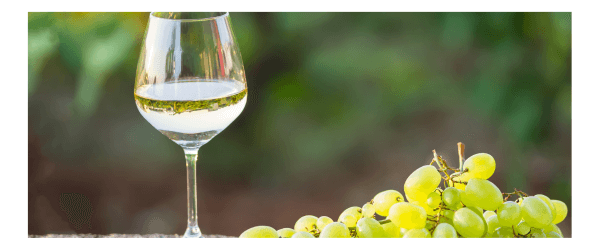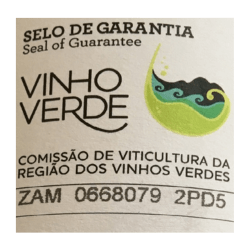No products in the basket.

Portugal is perhaps best known, wine-wise at least, for its fortified wine, port (about which you can read more in my port blogposts on ruby port and tawny port) but the largest wine region in Portugal is actually Vinho Verde – and the UK is its second biggest export market after France. Nevertheless vinho verde remains a bit of a mystery wine with a reputation for being a bit ‘rustic’, a bit fizzy and a bit sweet, all in all not very appealing. But vinho verde has been undergoing a long, slow revolution which is seeing its quality improve, a variety of styles develop and its exports grow. And summer is the perfect time to try vinho verde as we will discover.
The usual characteristics of vinho verde are:
Vinho verde can be made from permitted grape varieties either as a blend or as a 100% varietal wine. The flavour profile will depend partly on the grapes used – and there are many varieties permitted, mostly grapes that are indigenous to the region. When Márcio Lopes started up Pequeños Rebentos he initially grew just Alvarinho and Trajadura (known as Albariño and Treixadura in Spain) but he started producing vinho verde from local varietal Loureiro in 2016 having realised the fine, elegant wine that could be produced from it. Loureiro will give floral aromas and a long citrus and mineral finish on the palate.

Alvarinho also has the potential to produce quality wines and so many producers use it in part and increasingly on its own for their vinho verde. Rather than the peachy aromas that you see in Spanish Albariño from the Rías Baixas especially, vinho verde made from Alvarinho creates quite sharp, fragrant and fruity wines.
As a general rule vinho verde is light, crisp and citrussy with saline minerality. It rarely sees oak and it is not produced to age but to drink young – vinho verde means green or young wine though some believe the green in the name refers or referred originally to the verdant surroundings of the region where it is produced.
The largest of 31 DOC wine regions, Vinho Verde DOC is in the cool north west of Portugal, an area which is strongly influenced by its proximity to the Atlantic ocean, which effectively means that it rains a lot. Soils are usually fertile and mainly granite so free draining which is good given that there is a risk of rot and mildew in a damp climate. The major downside is that it is difficult in cool climate wine regions for grapes to ripen sufficiently; the tradition in the small vineyards typical of the region was to train the vines to grow up tall pergolas or even up trees but now many train the vines along low wires and particular care is taken to trim the leaves of the vine to give the grapes the best chance to ripen.
Modern winemakers like Márcio Lopes practise sustainable viticulture and prefer low intervention, aiming to make wines with balance that reflect the terroir – there are nine sub-regions in the Vinho Verde DOC region – Monção, Melgaço, Lima, Basto, Cávado, Ave, Amarante, Baião, Sousa and Paiva – all with their own individual nuances in terroir.
True vinho verde will have a seal like this one on the back of the bottle to certify that the wine meets the Vinho Verde DOC region’s requirements and has been analysed and approved by the regulator, the CVRVV (Comissão de Viticultura da Região dos Vinhos Verdes).
Any wines from the region that don’t have this seal will be from the lower category of wine in Portugal, ‘vinho regional’, the equivalent of ‘vin de pays’ or these days IGP wines or simply ‘vinho’, the catch-all lowest rank.
Vinho verde is not generally produced for keeping but, having said that, better vinho verde wines can keep longer. Although some producers are experimenting with oak which would provide a structure more suited to ageing, oak has a tendency to overpower the grapes used to produce it and so needs very careful handling. Vinho verde is produced for drinking young, at 1 to 2 years of age though well made vinho verde that has been kept on its lees for a few months to give it some body can keep a few years longer.
And if ever there were a summer wine, vinho verde is it! Its light body, low alcohol and really crisp character is perfect on hot, sunny days though it would be a refreshing drink at any time of year. Serve chilled at 8 – 10°C. And, if you just prefer a lower alcohol wine, this could be the wine for you!
Given its lovely acidity vinho verde can be consumed without food, as an aperitif or at a get-together with friends but in terms of food, what can I say… due to the hint of saline minerality usually found in the wine, vinho verde is meant for fish – and many different types of fish and fish dishes including…
…especially if you haven’t tried it before. You should try it if you are a fan of
aromatic wines like Albariño, Soave, Pinot Blanc and Grüner-Veltliner
but also if you like
crisp light wines like Sauvignon Blanc, Picpoul and Gavi.
And if you happen to be in Porto in July, you can try the different styles of vinho verde at the Vinho Verde Wine Fest where in some years you can also meet the amiable Márcio Lopes who makes the fabulous Pequeños Rebentos Loureiro.
© 2014-2025 Wines with Attitude Ltd | VAT Reg. No. 181 2419 22 | Registered in England 08918466 | Fiveways, 57-59 Hatfield Road, Potters Bar, Herts, EN6 1HS